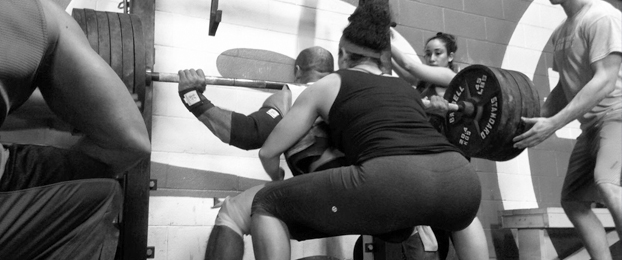
The question of how deep you should go in the squat is constantly debated. Many athletes are interested in the depth of the squat in relation to knee safety. Going deep so that the buttocks almost touch the heels is deemed dangerous to the knees for some athletes. However, it’s fine for high-level athletes. The positioning of the knee in relation to the feet (whether the knees are in front of the feet or in vertical alignment with the toes) is also of concern. Some believe that the knee shouldn’t go beyond the base of the feet while others feel that it makes no difference and is perfectly safe.
However, few examine prerequisite exercises that can help make the squat safe regardless of depth. For example, foremost in squat safety is whether or not you maintain an arch in the lower back during the ascent and descent. Even though this is mentioned as important, it isn’t given high priority. Yet, it should be the number one factor in determining squat depth.
Maintaining the lumbar spine arch is important for back safety. It is also the critical element in determining whether or not you engage the hamstrings and gluteus maximus muscles. For example, if you allow the lower back to flex (get rounded) as you lower the body, more slack is given to the hamstrings. As a result, you have to go much deeper before the hamstrings and gluteus maximus come into play.
The number one cause of back injuries in strength training is rounding the lumbar spine while performing the squat. Because of this, the back arch should be the main concern when doing the squat, especially if you use heavy weights. If no weights are used, a rounded back may be safe if the muscles are sufficiently strong. With ample resistance, the squat with a rounded back can cause severe problems to the spinal discs and vertebrae. It can even cause discs to rupture.
If holding the arch in the lower back is the main requisite for a safe and effective squat, then maintaining the arch should be your number one concern. In my experiences, maintaining the arch is very difficult for most athletes. If it’s truly maintained throughout the execution, most athletes don’t approach the thigh level position even if they’ve been doing the squat for many years. It isn’t only beginners who have difficulty holding proper spinal position. It occurs with high-level athletes as well.
So the main focus should be on whether or not the athlete maintains the arch in the lower back. Once the arch is lost or the athlete loses the arch, the descent should stop immediately. This point in the range of motion determines the depth to which one should go in the squat. If the arch is maintained and the athlete goes lower, other factors such as the positioning of the knee become important. If the knees move too far forward beyond the base of support, it’s important to examine foot placement, Achilles tendon flexibility, amount of forward lean of the trunk, or the positioning of the hips. All of these factors have multiple variants and depend on the objective of the squat. For example, runners and jumpers have the feet directly under the hips while powerlifters have the feet outside the hips. A 45-degree forward trunk lean angle is usually considered ideal, but it can vary up or down depending on the individual.
The problem of squat execution becomes even more complex when dealing with specificity of training and training transfer. For example, should the athlete do a deep, full (thigh level position) or half squat (or all three variants) to improve jump height, running speed, or cutting actions? When should these variants be performed (specific phase) in the periodization plan? Answers to these questions require a separate article.
Even though most exercises are relatively simple, exercise technique can be quite complex. Most books and magazines dealing with strength training show and describe exercises in about one or two paragraphs accompanied with one or two photos. Only Kinesiology of Exercise treats exercise execution in full detail. It describes muscle involvement and discusses all details regarding execution of the exercise including what happens if you deviate from proper execution or if you use a different stance, position, or grip.








